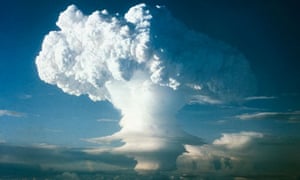 |
The mushroom cloud after the detonation of the
nuclear device Ivy MIke in 1951 in the Marshall Islands.
|
Mushroom-shaped clouds and
their causes
Weatherwatch:
David Hambling
In 16 July 1945 an ominous new type of cloud formed over the desert near Socorro, New Mexico.
It was created by the first atomic test, and
more than the brilliant fireball and tremendous blast, it was this mushroom
cloud which became the symbol of the atomic age.
However, mushroom clouds are not unique to
atomic explosions.
Any sufficiently powerful source of heat, such
as a volcano or forest fire can produce one. The heat creates a powerful
updraught, channelling dust and smoke from the ground into a narrow chimney,
forming the stalk of the mushroom.
This chimney continues to rise until it meets
an obstruction in the form of a boundary layer in the atmosphere. The rising
column then spreads out and forms the cap of the mushroom.
The boundary layer, the tropopause, typically
occurs at 30,000 to 50,000 feet, where air stops getting cooler with height and
starts getting warmer.
The tropopause is also the ceiling for
flat-topped cumulonimbus, the anvil-shaped clouds often associated with storms.
Forest fires may produce clouds of actual
water vapour, known as pyrocumulus, but atomic mushroom clouds are mainly
composed of smoke and dust.
Many witnesses described the Trinity cloud as
mushroom-shaped, but other terms were also used.
Accounts like one in Time magazine of 1960
called them "cauliflower" clouds, because of the roiling, uneven
smoke.
Since you’re here…
… we have a small favour to ask. More people, like you, are
reading and supporting the Guardian’s independent, investigative journalism
than ever before. And unlike many news organisations, we made the choice to
keep our reporting open for all, regardless of where they live or what they can
afford to pay.
The Guardian will engage with the most critical issues of our
time – from the escalating climate catastrophe to widespread inequality to the
influence of big tech on our lives. At a time when factual information is a
necessity, we believe that each of us, around the world, deserves access to
accurate reporting with integrity at its heart.
Our editorial independence means we set our own agenda and voice
our own opinions. Guardian journalism is free from commercial and political
bias and not influenced by billionaire owners or shareholders. This means we
can give a voice to those less heard, explore where others turn away, and
rigorously challenge those in power.
We hope you will consider supporting us today. We need your
support to keep delivering quality journalism that’s open and independent.
Every reader contribution, however big or small, is so valuable. Support The Guardian from as little as $1 – and it
only takes a minute. Thank you.


No comments:
Post a Comment